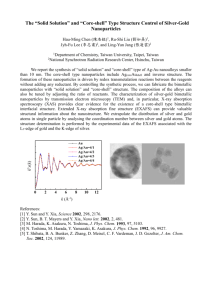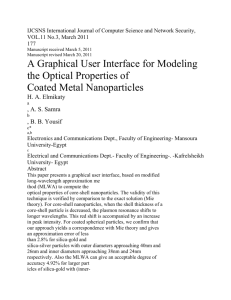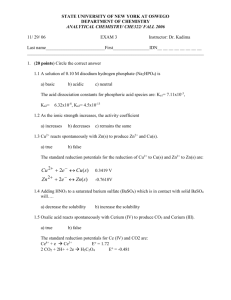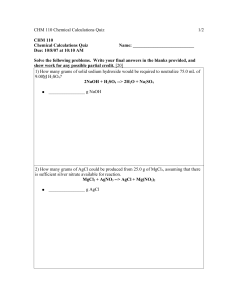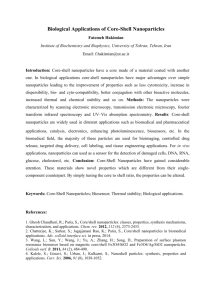Document 10767861
advertisement
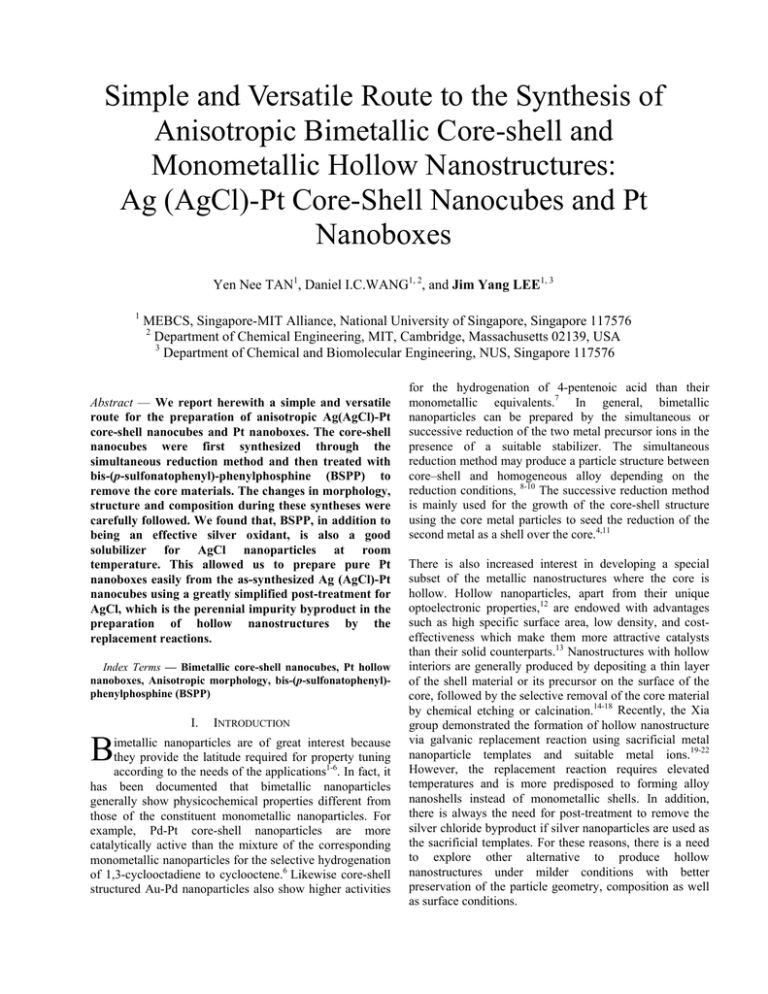
Simple and Versatile Route to the Synthesis of Anisotropic Bimetallic Core-shell and Monometallic Hollow Nanostructures: Ag (AgCl)-Pt Core-Shell Nanocubes and Pt Nanoboxes Yen Nee TAN1, Daniel I.C.WANG1, 2, and Jim Yang LEE1, 3 1 MEBCS, Singapore-MIT Alliance, National University of Singapore, Singapore 117576 2 Department of Chemical Engineering, MIT, Cambridge, Massachusetts 02139, USA 3 Department of Chemical and Biomolecular Engineering, NUS, Singapore 117576 Abstract — We report herewith a simple and versatile route for the preparation of anisotropic Ag(AgCl)-Pt core-shell nanocubes and Pt nanoboxes. The core-shell nanocubes were first synthesized through the simultaneous reduction method and then treated with bis-(p-sulfonatophenyl)-phenylphosphine (BSPP) to remove the core materials. The changes in morphology, structure and composition during these syntheses were carefully followed. We found that, BSPP, in addition to being an effective silver oxidant, is also a good solubilizer for AgCl nanoparticles at room temperature. This allowed us to prepare pure Pt nanoboxes easily from the as-synthesized Ag (AgCl)-Pt nanocubes using a greatly simplified post-treatment for AgCl, which is the perennial impurity byproduct in the preparation of hollow nanostructures by the replacement reactions. Index Terms — Bimetallic core-shell nanocubes, Pt hollow nanoboxes, Anisotropic morphology, bis-(p-sulfonatophenyl)phenylphosphine (BSPP) B I. INTRODUCTION imetallic nanoparticles are of great interest because they provide the latitude required for property tuning according to the needs of the applications1-6. In fact, it has been documented that bimetallic nanoparticles generally show physicochemical properties different from those of the constituent monometallic nanoparticles. For example, Pd-Pt core-shell nanoparticles are more catalytically active than the mixture of the corresponding monometallic nanoparticles for the selective hydrogenation of 1,3-cyclooctadiene to cyclooctene.6 Likewise core-shell structured Au-Pd nanoparticles also show higher activities for the hydrogenation of 4-pentenoic acid than their monometallic equivalents.7 In general, bimetallic nanoparticles can be prepared by the simultaneous or successive reduction of the two metal precursor ions in the presence of a suitable stabilizer. The simultaneous reduction method may produce a particle structure between core–shell and homogeneous alloy depending on the reduction conditions, 8-10 The successive reduction method is mainly used for the growth of the core-shell structure using the core metal particles to seed the reduction of the second metal as a shell over the core.4,11 There is also increased interest in developing a special subset of the metallic nanostructures where the core is hollow. Hollow nanoparticles, apart from their unique optoelectronic properties,12 are endowed with advantages such as high specific surface area, low density, and costeffectiveness which make them more attractive catalysts than their solid counterparts.13 Nanostructures with hollow interiors are generally produced by depositing a thin layer of the shell material or its precursor on the surface of the core, followed by the selective removal of the core material by chemical etching or calcination.14-18 Recently, the Xia group demonstrated the formation of hollow nanostructure via galvanic replacement reaction using sacrificial metal nanoparticle templates and suitable metal ions.19-22 However, the replacement reaction requires elevated temperatures and is more predisposed to forming alloy nanoshells instead of monometallic shells. In addition, there is always the need for post-treatment to remove the silver chloride byproduct if silver nanoparticles are used as the sacrificial templates. For these reasons, there is a need to explore other alternative to produce hollow nanostructures under milder conditions with better preservation of the particle geometry, composition as well as surface conditions. (a) (b) Figure 1. TEM images of (a) Ag (AgCl)-Pt core-shell nanocubes; (b) Pt nanoboxes (obtained after treated with BSPP) The catalytic reactivity of metal nanoparticles is undoubtedly linked to the particle shape and the nature of the surfaces involved in catalysis. Among the various metal nanoparticles, platinum or platinum-containing nanocomposites have been most noted for their activity and selectivity in hydrogenation and visible light induced hydrogen evolution10, 23-26. El-sayed et al. have demonstrated the shape-controlled synthesis of monometallic platinum nanoparticles and reported that cubic Pt nanoparticles would exhibit greater catalytic activities compared to spherical particles. The dissolution and surface reconstruction of atoms on the (100) facets of the cubic nanoparticles could take place during the reaction and thus, creates defective and more active sites. This might explain the decrease in the activation energy observed when using the cubic nanoparticles for the catalytic reaction. 27-28 However, there are very limited studies on the shape-controlled of platinum-containing bimetallic systems and only a few studies on the preparation of Pt-Ag bimetallic nanoparticles. For examples, Liz-Marzan and Philipse prepared imogolite fibers immobilized Ag(core)–Pt(shell) bimetallic nanoparticles by the simultaneous reduction of the two metal salts with sodium borohydride29, while Remita et al.30 and Wu et al.31 synthesized alloy Pt/Ag nanoparticles through radiolysis and water-in-oil microemulsions respectively. Although these methods have already been demonstrated for the synthesis of bimetallic nanostructures, the resultant nanostructures are usually spherical in shape. Thus, it is desirable to develop a method that is able to produce bimetallic nanostructures with an anisotropic morphology. In this study, Ag(AgCl)-Pt core-shell nanocubes were synthesized by the simultaneous sodium citrate reduction of the metal precursor salts. These novel tri-layer core-shell nanostructures were characterized by transmission electron microscopy (TEM), analysis of the electron diffraction patterns, energy-dispersive X-ray analysis (EDX), and Xray photoelectron spectroscopy (XPS). Bis-(psulfonatophenyl)-phenylphosphine (BSPP), which is a known a silver oxidant32, was also found to be a good AgCl solubilizer, and was used to produce the Pt-hollow nanoboxes. This led to a substantial simplification of the post-treatment process required for the removal of AgCl, which is the predominant impurity byproduct in the replacement reaction route to hollow nanostructure synthesis. II. EXPERIMENTAL SECTION Materials. AgNO3 (99.8%) and H2PtCl6 (99.9%) from Aldrich, sodium citrate (98%) from Merck and bis-(psulfonatophenyl)-phenylphosphine (BSPP) dihydrate dipotassium salt (97%) from Strem Chemicals were used as received. Deionized water was distilled by a Milli-Q water purification system. All glassware and Teflon-coated magnetic stir bars were cleaned in aqua regia, followed by copious rinsing with distilled water before drying in an oven. Synthesis of Ag(AgCl)-Pt Core-Shell Nanocubes. In a typical synthesis, 10 mL of 1 mM aqueous solution of H2PtCl6 was mixed with 10 mL of 1 mM aqueous solution of AgNO3 at room temperature. The mixture of metal precursors was then refluxed at 1000C for 5mins in an oilbath. 2 mL of 40 mM tri-sodium citrate solution was added quickly, and reflux continued for another 4 hour. A yellowish brown hydrosol was produced. Synthesis of Pt Nanoboxes. For the etching of the Agcontaining cores from Ag(AgCl)-Pt core-shell nanocubes, 15mg of solid K2BSPP was added to 5ml of the assynthesized bimetallic nanocubes prepared above. The mixture was aged for more than 3 hours to complete the oxidative dissolution of Ag and AgCl. No color change of the hydrosol was observed upon the addition of K2BSPP. Characterizations. A JEOL JEM2010 microscope was used to obtain TEM images of the nanoparticles. For TEM measurements, a drop of the nanoparticle solution was Figure 2. High resolution TEM images of (a) Ag(AgCl)-Pt core-shell nanocube with a lattice spacing of 0.231 nm was determined and (b) Pt nanobox with the discontinuous shell showing the disappearance of the crystal lattice structure at the central of nanobox. dispensed onto a 3-mm copper grid covered with a continuous carbon film. Excess solution was removed with an adsorbent paper. The sample was dried under vacuum at room temperature. The nanoparticles before and after BSPP treatment were analyzed by EDX JEOL MP5600 scanning electron microscope (SEM) and by XPS on a VG ESCALAB MKII spectrometer. Samples were drawn from the nanoparticles recovered in the aqueous phase by centrifugation, which were then washed copiously with distilled water and vacuum dried at room temperature. III. RESULTS AND DISCUSSION Synthesis and Characterization of Ag(AgCl)-Pt CoreShell Nanocubes and Pt Nanoboxes. (1) Morphology Analysis: Ag (AgCl)-Pt tri-layer coreshell nanocubes were obtained by the simultaneous reduction of Ag and Pt precursor salts using a mild reducing agent, sodium citrate. The reduction kinetics was controlled to promote the formation of the anisotropic shape. These bimetallic structures were subsequently used to produce Pt nanoboxes by the BSPP etching of the silvercontaining cores. Figure 1 shows the representative TEM images of the Ag(AgCl)-Pt core-shell nanocubes and Pt nanoboxes at relatively low magnifications. Over 95% of the hollow structures (Figure 1b) had inherited the cubic shape of the starting cubes (Figure 1a).This shows that BSPP served not only as the etchant to remove the Agcontaining cores but also as the substitute stabilizer for the initially citrate-stabilized core-shell nanocubes. Therefore, the removal of the cores from the Ag(AgCl)-Pt core-shell nanocubes did not lead to the collapse of the cubic geometry. (2) Structure Analysis: The structure of the Ag(AgCl)-Pt core-shell nanocubes was analyzed by high resolution TEM imaging. The core-shell structure was identified by the distinct brightness difference between the inner and outer regions of the nanocubes as shown in Figure 2a. Additional structural details were revealed by the lattice fringes with a spacing of 0.231 nm in the core area. However, the superposition of interference patterns from two highly similar fcc metals (d (111) for Ag and Pt are 0.2356 and 0.2255nm respectively) makes it difficult to differentiate between Ag and Pt in the HRTEM image. Thus, a simple method based on the selective oxidation of Ag by BSPP was used to confirm the core-shell construction in the bimetallic nanocubes. A comparison of the TEM images of Ag(AgCl)-Pt core-shell nanoparticles before (Figure 1a) and after (Figure 1b) BSPP oxidation shows only the removal of the core, with virtually no change in the particle size. The HRTEM image in Figure 2b shows a discontinuous Pt shell of individual Pt nanoparticles initially decorating the now-removed Agcontaining core. The lattice fringes no longer apparent in the lighter core area, but remains vaguely visible for the darker spots, indicating that the 0.231nm lattice fringes initially observed could be attributed to the d(111) diffraction of Ag. The formation of the discontinuous Pt shell on the Ag-containing core was important, as it allowed BSPP penetration to oxidize the underlying Ag core and to solubilize AgCl (see later). (3) Composition Analysis: The chemical compositions of the bimetallic nanoparticles were analyzed by EDX and XPS. It should perhaps be mentioned that a white solid appeared at the bottom of the reaction vessel when the reaction mixture was cooled to room temperature. This was due to the precipitation of AgCl which has a reduced solubility at lower temperatures. In order to prevent the AgCl precipitate from interfering with the composition analysis, the bimetallic nanocubes were first treated with supersaturated NaCl solution to solubilize AgCl through the coordination reaction shown below.33 − AgCl ( s ) + 3Cl − (aq ) → AgCl 4 (aq) (1) (a) XPS analysis indicated none. This rules out the possibility of AgCl adsorption on the nanocube surface or its presence as a separate entity or contaminant in the solution phase (since the nanocubes were purified with supersaturated 42 NaCl solution). AgCl was therefore part of the core 31 component. AgCl could have resided deep in the core area with22protection from the Ag and Pt layers preventing its 20 solubilization by saturated NaCl. 11 (b) (c) The BSPP-treated nanocubes showing a hollow interior were also analyzed by EDX. The EDX spectrum is dominated by the Pt signal with several Cu peaks from the TEM grid, and no Ag (Figure 3b). The electron diffraction (ED) patterns of the Pt nanoboxes show several bright concentric rings (Figure 3c) attributable to the diffractions from the [111], [200], [311] and [420] crystal planes of fcc polycrystalline metal Pt34. The BSPP-treated Ag(AgCl)-Pt core-shell nanocubes contained therefore only a Pt outer shell. BSPP therefore served not only as a silver oxidizer, but also as a more effective solubilizer for AgCl than saturated NaCl. BSPP as a Ag Oxidant cum AgCl Solubilizer. A simple control experiment was carried out to confirm the solubilizing action of BSPP. AgCl nanoparticles were first centrifuged out from the reaction mixture before reduction with sodium citrate. The precipitate was divided between two reaction tubes followed by the addition of BSPP and saturated NaCl respectively. An immediate color change from a cloudy yellow to colorless solution was observed. This shows that BSPP was able to solubilize AgCl as good as saturated NaCl, if not better. In addition, TEM imaging of samples drawn from the colorless solution showed no presence of particles. However, the mechanism of BSPP solubilization may be different from that of NaCl. It is believed that BSPP chelated with the silver ions, forming BSPP-Ag+ complexes that disrupted the following equilibrium of AgCl in solution: Figure 3. EDX analyses of core-shell Ag(AgCl)-Pt nanocubes before (a) and after (b) BSPP treatment, respectively. (c) Typical electron diffraction pattern of Pt nanoboxes show several bright concentric rings correspond to the crystal plane of fcc metal Pt The purified nanocubes were collected by centrifugation and then redispersed in water for subsequent analyses. The EDX spectrum in Figure 3a shows emission peaks associated with Pt and Ag, and a calculated Ag to Pt atomic ratio of 18:82. On the other hand, XPS analysis of the surface of the bimetallic Ag-Pt nanocubes showed a much lower Ag to Pt ratio of 6: 94, indicating that the surface of the bimetallic nanostructure was enriched with Pt. The difference in elemental compositions between XPS (a surface analysis technique) and EDX (a bulk analysis technique) measurements is strong evidence for the formation of a Pt shell on the Ag-containing core. EDX also detected a noticeable amount of Cl (Figure 3a) while Ag + (aq) + Cl − (aq ) ↔ AgCl ( s ) (2) The decrease in the free silver ion concentration in the solution due to the formation of BSPP-Ag+ complexes shifted the equilibrium to the left, resulting in the dissolution of AgCl nanoparticles. IV. CONCLUSION In summary, we have demonstrated a simple and versatile route for the preparation of anisotropic Ag(AgCl)-Pt coreshell nanocubes and Pt nanoboxes. The core-shell nanocubes were first synthesized and the discontinuous Pt shell on the silver-containing core allowed BSPP to diffuse through the shell to dissolve the underlying core materials, leaving a Pt shell with the cubic geometry intact. The method leverages heavily on the bifunctionality of BSPP as a Ag oxidizer and a AgCl solubilizer, which was discovered for the first time. This new process addresses the problem of AgCl contamination in the replacement reaction synthesis of hollow structures using sacrificial Ag nanoparticle templates19-22. ACKNOWLEDGMENT This work was supported by Singapore-MIT Alliance. Y.N.T. would like to acknowledge Singapore –MIT alliance for the financial support and thank Dr. Yang Jun for his helpful discussion. REFERENCES [1] Schmid, G. Clusters and Colloids; VCH: Weinheim, Germany, 1994. [2] Cao, Y.-W.; Jin, R.; Mirkin, C. A. J. Am. Chem. Soc. 2001, 123,7961. [3] Link, S.; Wang, S. Z. L.; El-Sayed, M. A. J. Phys. Chem. B, 1999, 103, 3529. [4] Mallin, M. P.; Murphy, C. Nano Lett.2002, 2, 1235. [5] Ah, C. S.; Hong, S. D.; Jang, D.-J. J. Phys. Chem. B, 2001, 105,7871 [6] Toshima, N.; Yonezawa, T. New J. Chem. 1998, 22, 1179. [7] Mizukoshi, Y.; Fujimoto, T.; Nagata, Y.; Oshima, R.; Maeda, Y. J. Phys.Chem. B, 2000, 104, 6028. [8] B. Bian, Y. Hirotsu, K. Sato, T. Ohkubo, A. Makino, J. Electron Microsc. , 1999, 48, 753. [9] M. Treguer, C. Cointet, H. Remita, J. Khatouri, M. Mostafavi, J. Amblard, J. Belloni, R. Keyzer, J. Phys. Chem. ,1998 ,102 , 4310. [10] J. Belloni, M. Mostafavi, S. Remita, J.L. Marignier, M.O. Delcourt, New J. Chem., 1998,1239. [11] Smova-Sloufova, I.; Lednicky, F.; Gemperle, A.; Gemperlova, J .Langmuir, 2000, 16, 9928. [12] Kociak, M.; Ste´phan, O.; Henrard, L.; Charbois, V.; Rothschild, A.; Tenne, R.; Colliex, C. Phys. ReV. Lett., 2001, 87, 075501-1-075501- 4. [13] Kim, S. W.; Kim, M.; Lee, W. Y.; Hyeon, T. J. Am. Chem. Soc., 2002, 124, 7642. [14] Chah, S.; Fendler, J. H.; Yi, J. J. Colloid Interface Sci., 2002, 250, 142. [15] Caruso, F.; Caruso, R. A.; Mohwald, H. Science, 1998, 282, 1111. [16] Caruso, F.; Spasova, M.; Maceira, V.; Marzan, L. M. AdV. Mater., 2001, 13, 1090. [17] Oldenburg, S. J.; Averitt, R. D.; Westcott, S. L.; Halas, N. J. Chem. Phys. Lett., 1998, 248, 243. [18] Dhas, N. A.; Suslick, K. S. J. Am. Chem. Soc., 2005, 127, 2368. [19] Sun, Y.; Xia, Y. Science, 2002, 298, 2176. [20] Sun, Y.; Mayers, B. T.; Xia, Y. Nano Lett. , 2002, 2, 481. [21] Sun, Y.; Mayers, B. T.; Xia, Y. Adv. Mater., 2003, 15, 641. [22] Sun, Y.; Xia, Y. J. Am. Chem. Soc., 2004, 126, 3892. [23] Y. Wang, N. Toshima, J. Phys. Chem. B, 101 (1997) 5301. [24] G. Schmid, H. West, J.O. Malm, J.O. Bovin, C. Grenthe, Chem. Eur. J., 1996, 2, 1099. [25] N. Toshima, T. Yonezawa, K. Kushihashi, J. Chem. Soc. Faraday Trans. ,1993, 89. 2537. [26] T. Yonezawa, N.N. Toshima, J. Mol. Cat. ,1993, 83, 167. [27] R. Narayanan and M.A.El-sayed, J.Am.Chem.Soc., 2004, 126, 7194. [28] S.Ahmadi, T.; L.Wang, Z.; C.Green, T.; Henglein, A.; A.El-Sayed, M. Science., 1996, 272, 1924-1925. [29] L.M. Liz-Marzan, A.P. Philipse, J. Phys. Chem., 1995, 99, 15120. [30] S. Remita, M. Mostafavi, M.O. Delcourt, Radiat. Phys. Chem., 1996, 47, 275. [31] Wu, M.-L.; Lai, L.-B. Colloids and Surfaces A: Physicochem. Eng. Aspects , 2004, 244, 149–157 [32] Yang, J.; Lee, J. Y.; Too, H.P.; Valiyaveettil, S. J. Phys. Chem. B, 2006, 110, 125-129. [33] Lampre, I.; Pernot, P.; Mostafavi, M. J. Phys. Chem. B 2000, 104, 6233. [34] JCPDS, X-rays Powder Diffraction Patterns of fcc Platinum (Data No. 04-0802)
